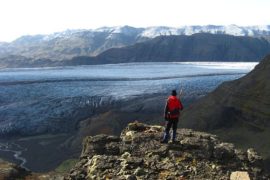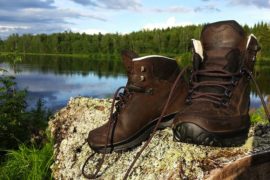You may well have heard of the health benefits of using Nordic walking poles, but what are these miracle sticks and why are they so good for you?
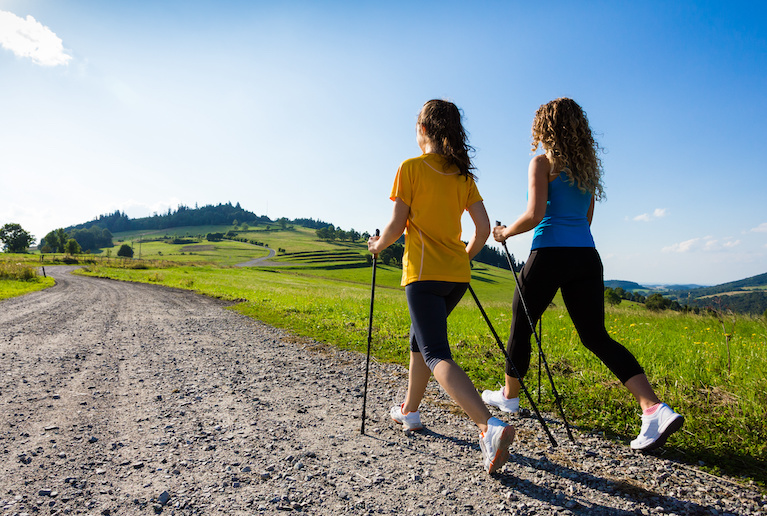
Well, they started out as a training tool for cross-country skiers in Scandinavia, but quickly spread to become a global fitness tool for walkers and hikers, especially in the snowy parts of USA and Canada.
These lightweight adapted ski poles can help improve your posture while walking and give your whole body a work-out, not just your legs!
So, what are the best Nordic walking poles, how do you get the right ones for you and where can you can buy them?
There’s a whole world of walking poles out there and the choice can be overwhelming, but we’ll help you find the perfect set.
Not sure what Nordic walking even is? Start with this guide instead!
Types of Nordic walking poles
First of all you need to decide what type of pole you want. And that will depend on how often you go walking, what sort of terrain you walk on and how much you want to spend.
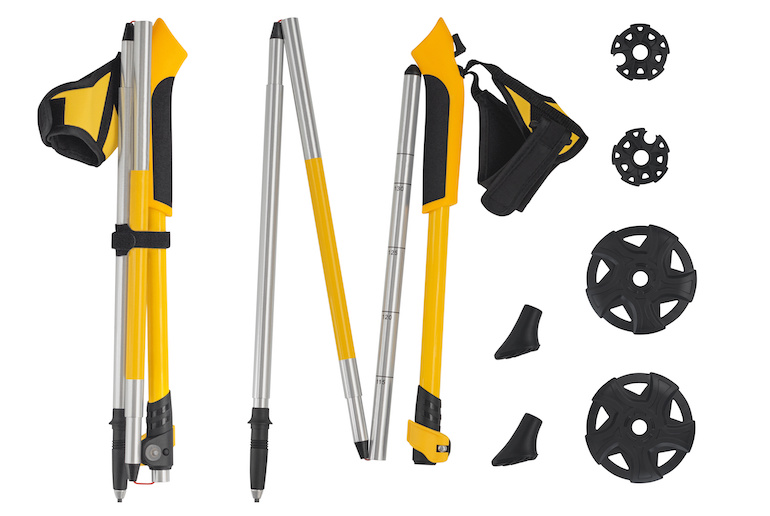
Poles comes in a bewildering array of types and can cost anything from $50–200 a pair (approx £40–150).
Fixed length poles are the most solid and reliable, though you’ll have to make sure you get the correct size and they can’t be packed for travel.
Adjustable poles have one extension point in the middle of the shaft so that you can adapt them to different heights – useful if more than one person wants to use them, or if you’re walking on different types of terrain.
And, as their name suggests, foldable sticks can be folded in two or three places, so they are more lightweight and can be packed up small to travel with.
Most poles are made from carbon fibre, aluminium or a mixture of the two. Carbon fibre poles are lighter and absorb more vibrations on hitting the ground, but they cost more.
So if you’re a newcomer to Nordic walking, we suggest starting off with adjustable, aluminium poles.
Size and fit
When buying Nordic walking poles, sizing is key. To get the best from your Nordic poles you’ll need to make sure you get the height right.
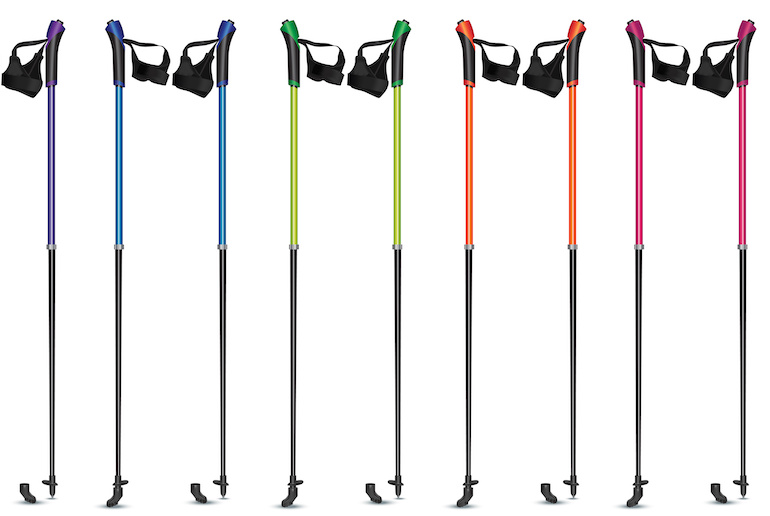
If you’re buying fixed length poles, the standard advice is to buy 0.68 of your height. So if you’re 170cm tall, you’ll need poles of 115cm.
And when you’re holding your poles at the handles, your forearm should be horizontal or bent just slightly lower. The same principles apply when you’re setting up your adjustable or foldable poles.
Bear in mind that if you’re just starting to use poles, a shorter pole length may feel more comfortable. As you get more used to them, and your posture improves, you may need to lengthen the poles.
You’ll also need to make sure that the glove-strap fits. Most Nordic poles come with gloves to fit a standard man’s hand, but suppliers will usually change the glove size for free.
Features to consider
Poles come with a whole array of different types of grid, strap and tip. So, how do you know which to choose?
One of the key features of Nordic poles is the glove-type strap, which goes from the wrist up to the palm and includes a separate thumb hole.
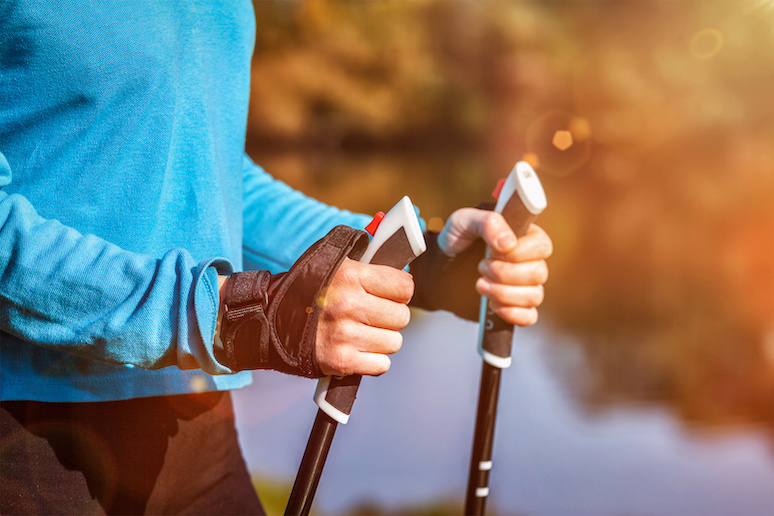
This means that the pole is attached to your hand, so that you can swing your arm and use more body power than with a looped strap on a walking pole. They usually also have a quick-release system for the glove.
Cheaper Nordic poles tend to come with a rubber grip, which is non-slip, durable and relatively soft.
EVA foam grips cost a little more, and are better at managing sweat, while top-of-the-range cork grips are lightweight, durable and best at moisture management, so you don’t get sweaty palms.
If you’re looking at adjustable poles, they usually come with a twist-lock mechanism or a clip-lock system.
Twist-locks are fine for everyday use, but if you need to adjust the height of your poles regularly while walking over different terrains and gradients, clip-locks can be easier.
And finally, Nordic poles come with a tip, usually made of tungsten carbide, and a rubber paw. The tip provides grip when walking on grass or soft terrain and the paw can be used on tarmac or hard surfaces.
Is there actually any benefit to using Nordic walking poles?
So what are the advantages of Nordic walking poles vs trekking poles?
It’s well documented that using Nordic poles can improve your posture, provide a full-body cardiovascular work-out and reduce the pressure on your joints.

Using poles engages the upper body muscles and helps to keep you in an upright and symmetrical position when walking.
It strengthens the upper body by activating the muscles in your shoulders, arms and core as well as your legs.
You’re also more stable, so are less likely to fall when out walking on rough terrain.
Not only that but, according to the Harvard Medical School, walking with Nordic poles can use up to 50 percent more calories than regular walking.
And it can help reduce cholesterol, ease depression and increase muscle strength and flexibility.
Where can you buy Nordic walking poles?
When buying Nordic walking poles, Ebay, Walmart, Costco and Amazon are all good places to look.
Buying online is good if you know what size and type you want, and it gives you access to a large range of different brands and styles.
If you want to try your poles before buying, Walmart and Costco in the US and Mountain Warehouse and Decathlon in the UK all stock them, though they may have a more limited range in individual stores.
Our favourite brands and models
So which are the best poles for Nordic walking? We like Leki Nordic walking poles, which come in a huge range of style and types and are generally regarded to be among the most reliable brands.
Leki is the world’s largest manufacturer of Nordic poles and makes good quality poles to suit all budgets.
Norwegian company Swix’ Nordic walking poles are also well-regarded and come in a variety of styles. We also like Exel, a Finnish company that has been making high-quality Nordic poles for more than 60 years.
Here are five of our favourite Nordic walking poles.
FitTrek Nordic walking poles
These are a great-value entry-level pair of poles, made from lightweight aluminium. We love that they can be adjusted from 120cm to 180cm so are suitable for all heights from children to adults.
They also come in a range of colours, including pink, blue and red.
Gabel Vario adjustable poles
For a mid-budget option, we like the Gabel Vario adjustable Nordic poles. Made from aluminium, they have a quick release glove system, and come in a cool lime green colour.
Leki Cross Trail Lite poles
The Leki Cross Trail Lite poles are also a good mid-range choice, with a lightweight carbon fibre shaft that folds into three pieces with a click-lock clamp.
Exel Nordic Pro poles
If you’re looking for fixed length poles, the Exel Nordic Pro series is hard to beat. Made from lightweight carbon fibre, they come in a variety of sizes with an all-terrain tip and excellent shock absorbency.
Leki Micro Flash poles
At the top end of the range, we recommend these carbon fibre Nordic walking poles that were originally designed for trail running. They’re super light and fold down to an easily-packable 37cm at the touch of a button.
Safety tips and best practices
The good news is that walking with Nordic poles is a pretty low-risk activity.
Using poles is definitely safer than walking without them, as you’re less likely to trip or to put stress on your joints when walking on tough or steep terrain.
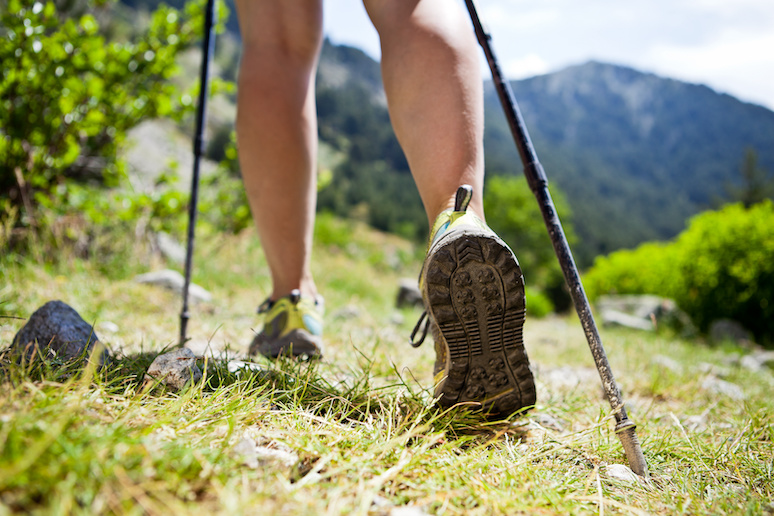
However, you can minimise the chance of any mishaps by perfecting your Nordic walking technique and following the tips below.
- Always make sure your poles are adjusted to the correct height.
- Hold your poles at 45 degrees.
- Place the pole in the ground near the back foot.
- Swing from the shoulder socket using a long straight arm.
There are plenty of Nordic walking groups around the country and we recommend that beginners go out with a group at first. That way, you can get advice on how to improve your technique – and it’s also a fun way to meet up with fellow walkers.
See also:
Walking the Kungsleden
The best long-distance hikes in Norway
Hiking in Abisko national park

